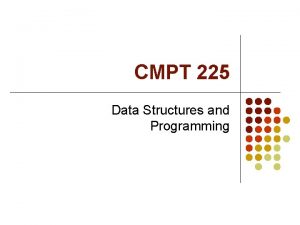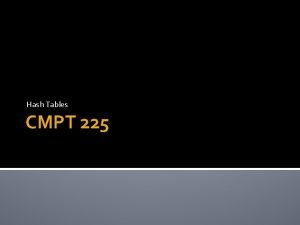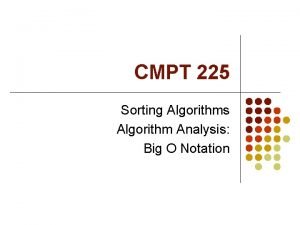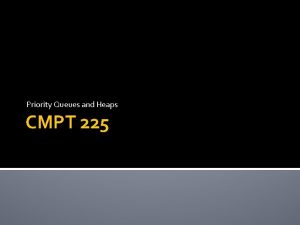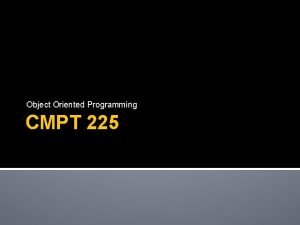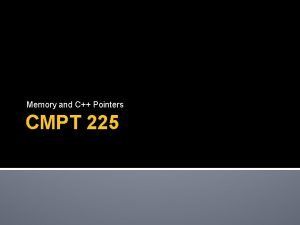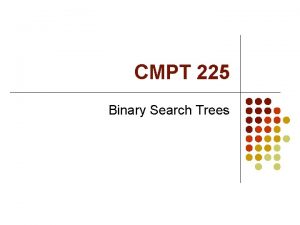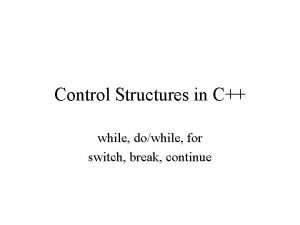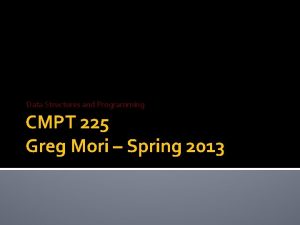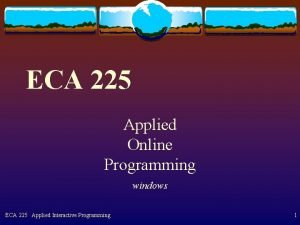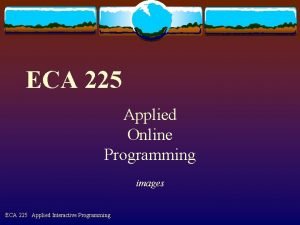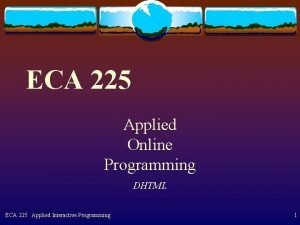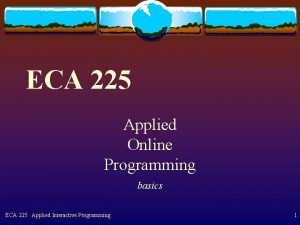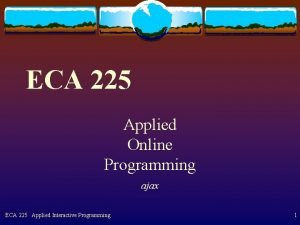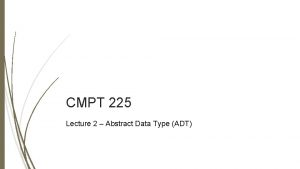CMPT 225 Data Structures and Programming Course information














- Slides: 14

CMPT 225 Data Structures and Programming

Course information l Lecturer: Jan Manuch (Jano), TASC 9405 Email: jmanuch@sfu. ca l TAs: l l Osama Saleh, osaleh@sfu. ca Maryam Moslemi Naeini, mmoslemi@cs. sfu. ca Course website: http: //www. cs. sfu. ca/CC/225/jmanuch/ Grades: https: //gradebook. cs. sfu. ca/


Course timetable l l Lectures: Mon, Wed, Fri: 1. 30 pm-2. 30 pm, West Mall 3210 Midterm: TBA Final Exam: TBA Office hours: l l Instructor: (2 hours) Mon, Wed, 2. 30 pm-3. 30 pm, T 9405 TA(labs): (3 hours) TBA

Grading scheme l l l Midterm: 25% Final: 45% Assignments: 30% (6 assignments each worth 5%) Late assignments: -20% each day l Shifting weights: l l It is possible to shift 50% of the midterm weight (that is 12. 5% of total weight) to final weight. No other shifts are possible!

CMPT 225 Topics l l l Software Development Process l Software Life Cycle l Specification, Design and Testing l Decomposition, Abstraction and Encapsulation Data Structures and Abstract Data Types l Arrays and Linked Lists l Stacks, Queues and Priority Queues l Trees (Binary, Red-Black, Heaps) and Graphs l Hash Tables Algorithms l O() Notation l Recursion l Sorting Algorithms

Course Objectives l Develop problem solving techniques l l Use abstraction to design solutions Design modular programs Use recursion as a problem-solving strategy Provide tools for the management of data l l Identify abstract data types (ADTs) Construct implementations of the ADTs

Problem Solving and Software Engineering l l l Coding without a solution design increases debugging time A team of programmers is needed for a large software development project Teamwork requires: l l An overall plan Organization Communication Software engineering l Provides techniques to facilitate the development of computer programs

What is Problem Solving? l Problem solving l l The process of taking the statement of a problem and developing a computer program that solves that problem A solution consists of: l l Algorithms l Algorithm: a step-by-step specification of a method to solve a problem within a finite amount of time Data structures to store the data and support the algorithms

What is a Good Solution? l A good solution is cost effective l l l To develop and maintain: l The total cost it incurs over all phases of the development process is minimal To run (i. e. to perform its task) l Difficulties encountered by those who use the program (Interaction cost) l Computer resources (time and memory) that the program consumes l Consequences of a program that does not behave correctly Programs must be well structured and documented Remark: Efficiency is only one aspect of a solution’s cost

Software Life Cycle Maintenance Specification Design Production Documentation Risk Analysis Refinement Verification Testing Coding

Software Life Cycle Phases - 1 l Specification l l l Design l l Plan the implementation of the application’s data and operations Plan the testing Risk Analysis Verification l l l Understand the client’s problem and requirements Ensure that the requirements are clear and complete and understood by all parties Ensure that algorithms are correct (methods: invariants, etc. ) Ensure that the design satisfies the requirements (validation) Implementation l Write application and test code

Software Life Cycle Phases - 2 l Testing l l l Refining Production l l Package, distribute and install application and train users Maintenance l l l Verify that code works Verify that the code meets the client’s requirements There are various types of testing techniques: unit testing, integration testing, system testing, user acceptance testing Add features Fix bugs Documentation l l Common to all the phases of the life cycle Includes the user manual

Software Life Cycle and CMPT 225 l We are primarily concerned with four phases of the life cycle l l Design Verification Implementation Testing
 Cmpt 225
Cmpt 225 Tables de 14
Tables de 14 Selection sort number of comparisons
Selection sort number of comparisons Cmpt 225
Cmpt 225 Cmpt 225
Cmpt 225 Cmpt 225
Cmpt 225 Cmpt225
Cmpt225 225 to binary
225 to binary Information retrieval data structures and algorithms
Information retrieval data structures and algorithms Information retrieval data structures and algorithms
Information retrieval data structures and algorithms Biology homology
Biology homology Course title and course number
Course title and course number C++ control structures
C++ control structures Stretcher bond t junction
Stretcher bond t junction Course interne moyenne externe
Course interne moyenne externe
